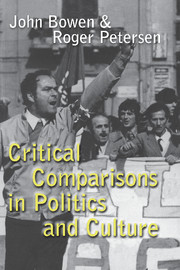Book contents
- Frontmatter
- Contents
- List of Figures
- List of contributors
- Acknowledgments
- 1 Introduction: critical comparisons
- 2 National revivals and violence
- 3 Mechanisms and structures in comparisons
- 4 Comparative methodologies in the analysis of anthropological data
- 5 The role of comparison in the light of the theory of culture
- 6 Case studies of contemporary job loss
- 7 Defining the contours of an Islamic reform movement: an essay in successive contrasts
- 8 Producing an analytic narrative
- 9 Political consciousness on Boa Ventura: 1967 and 1989 compared
- 10 Comparisons in the context of a game theoretic argument
- 11 The role of microhistories in comparative studies
- List of references
- Index of authors
- Subject index
2 - National revivals and violence
Published online by Cambridge University Press: 28 January 2010
- Frontmatter
- Contents
- List of Figures
- List of contributors
- Acknowledgments
- 1 Introduction: critical comparisons
- 2 National revivals and violence
- 3 Mechanisms and structures in comparisons
- 4 Comparative methodologies in the analysis of anthropological data
- 5 The role of comparison in the light of the theory of culture
- 6 Case studies of contemporary job loss
- 7 Defining the contours of an Islamic reform movement: an essay in successive contrasts
- 8 Producing an analytic narrative
- 9 Political consciousness on Boa Ventura: 1967 and 1989 compared
- 10 Comparisons in the context of a game theoretic argument
- 11 The role of microhistories in comparative studies
- List of references
- Index of authors
- Subject index
Summary
Nationalist movements seeking to make commensurate the boundaries of state and nation have in many cases employed or induced violence. Algeria, Basque Country (in Spain), Nazi Germany, Northern Ireland, Serbia, Somalia and Vietnam are gruesome examples. Yet the aims of comparable movements, similar in goals and apparently similar in context, have been resolved by relatively peaceful means. Quebec, Andhra Pradesh, Flanders, Italy and Catalonia are shining exemplars. This paper will employ the tools of game theory and the comparative method in political science (Lijphart 1971; Skocpol and Somers 1980; Collier 1991) to address the question: why are some nationalist movements peaceful in strategy and outcome while others create carnage? The answer is not to be found in the great forces of history, having to do with capitalism, state formation and inequality. Rather, the conditions that lead to violence require a microfoundation based upon social organization in rural and small-town life, tipping phenomena in political recruitment, and spiraling effects of fortuitous events.
Predominant approaches to the study of nationalism and violence have relied upon the identification of broad social processes that help to place nationalism in deep historical context (Kohn 1944). These approaches have pointed to the fact that nationalism is a modern social formation that emerged in the wake of industrial capitalism and concomitant modernization (Gellner 1983; Hobsbawm 1990). Capitalism in seventeenth-century Europe unleashed productive energies in a number of core zones, and these zones drew migrants from relatively depressed localities. This process, called “social mobilization” (Deutsch 1954), unhooked people from loyalties to tribe, village, and region.
- Type
- Chapter
- Information
- Critical Comparisons in Politics and Culture , pp. 21 - 60Publisher: Cambridge University PressPrint publication year: 1999
- 4
- Cited by



